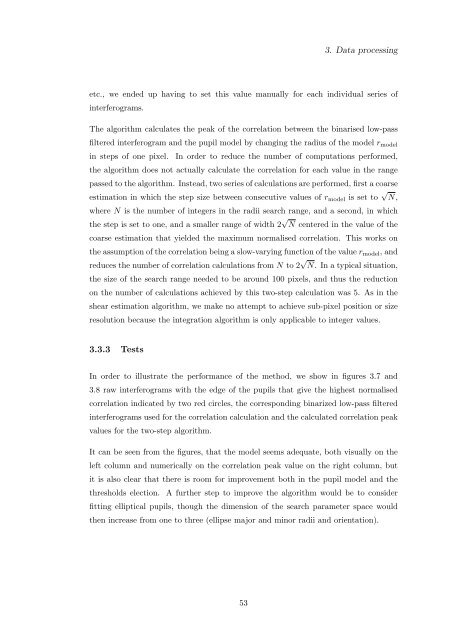Alfredo Dubra's PhD thesis - Imperial College London
Alfredo Dubra's PhD thesis - Imperial College London
Alfredo Dubra's PhD thesis - Imperial College London
Create successful ePaper yourself
Turn your PDF publications into a flip-book with our unique Google optimized e-Paper software.
3. Data processing<br />
etc., we ended up having to set this value manually for each individual series of<br />
interferograms.<br />
The algorithm calculates the peak of the correlation between the binarised low-pass<br />
filtered interferogram and the pupil model by changing the radius of the model r model<br />
in steps of one pixel. In order to reduce the number of computations performed,<br />
the algorithm does not actually calculate the correlation for each value in the range<br />
passed to the algorithm. Instead, two series of calculations are performed, first a coarse<br />
estimation in which the step size between consecutive values of r model is set to √ N,<br />
where N is the number of integers in the radii search range, and a second, in which<br />
the step is set to one, and a smaller range of width 2 √ N centered in the value of the<br />
coarse estimation that yielded the maximum normalised correlation. This works on<br />
the assumption of the correlation being a slow-varying function of the value r model , and<br />
reduces the number of correlation calculations from N to 2 √ N. In a typical situation,<br />
the size of the search range needed to be around 100 pixels, and thus the reduction<br />
on the number of calculations achieved by this two-step calculation was 5. As in the<br />
shear estimation algorithm, we make no attempt to achieve sub-pixel position or size<br />
resolution because the integration algorithm is only applicable to integer values.<br />
3.3.3 Tests<br />
In order to illustrate the performance of the method, we show in figures 3.7 and<br />
3.8 raw interferograms with the edge of the pupils that give the highest normalised<br />
correlation indicated by two red circles, the corresponding binarized low-pass filtered<br />
interferograms used for the correlation calculation and the calculated correlation peak<br />
values for the two-step algorithm.<br />
It can be seen from the figures, that the model seems adequate, both visually on the<br />
left column and numerically on the correlation peak value on the right column, but<br />
it is also clear that there is room for improvement both in the pupil model and the<br />
thresholds election. A further step to improve the algorithm would be to consider<br />
fitting elliptical pupils, though the dimension of the search parameter space would<br />
then increase from one to three (ellipse major and minor radii and orientation).<br />
53

















